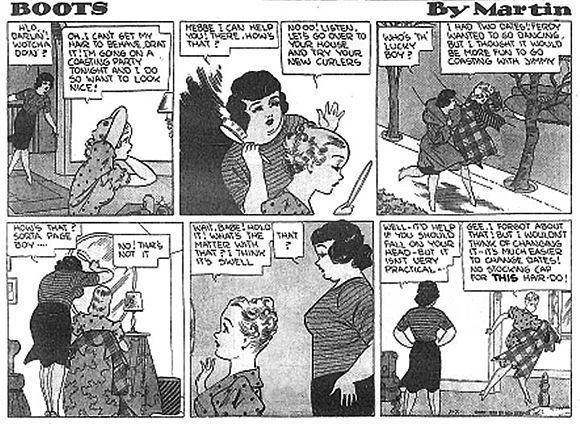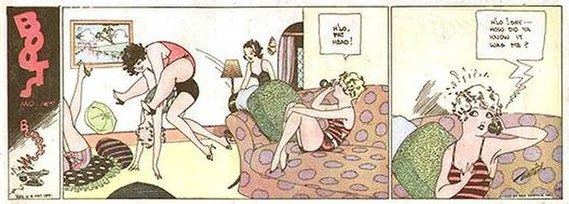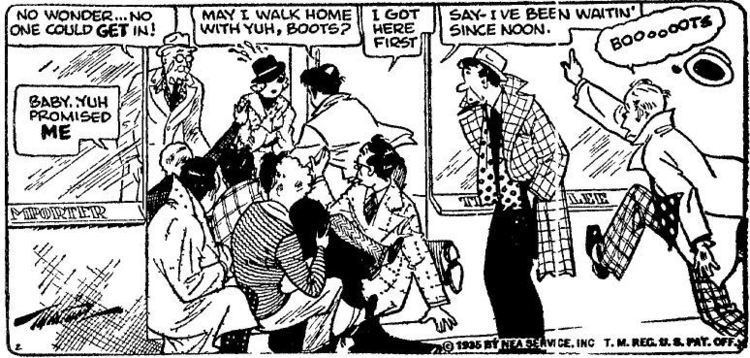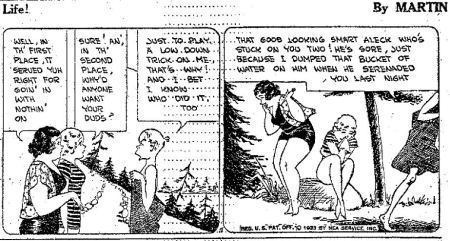 | ||
Similar Freckles and His Friends, Our Boarding House, Ella Cinders, Polly and Her Pals, Captain Easy | ||
Boots and Her Buddies was an American comic strip by Edgar Martin that ran from 1924 to 1969, syndicated by the Newspaper Enterprise Association. Some newspapers presented the strip under the shortened title Boots. The character of Boots was variously labeled the "Sweetheart of the Comics", the "Sweetheart of America" and "Everybody's Sweetheart".
Contents

Martin grew up in Monmouth, Illinois where his father, George Martin, was a Monmouth College biology professor, and he spent three years attending Monmouth College, leaving his junior year to study at the Chicago Academy of Fine Arts and joining NEA in 1921 as a cartoonist. Martin found work in 1921 in the NEA art department, and that same year he launched his strip, Girls, which had a character named Boots. Girls became Boots and Her Buddies on February 18, 1924, although some newspapers continued to use the first title.

Collegiate origins

When the strip began, the shapely, attractive Boots was attending college and boarding at the home of a professor and his wife. The "buddies" in the title originally referred to her college boy friends. The college in the strip was based on Monmouth College; Boots sometimes carried a banner with the letter "M". The town in the strip had numerous parallels with Monmouth, Illinois, occasionally displaying real locations, such as Sandy Mitchell's pool hall.

The Sunday strip began as a topper, positioned above Our Boarding House from 1926 to 1931. Because the strip had a large readership of college and high school students, Martin kept Boots in college for a very long time. With the strip's emphasis on fashion and beauty, Martin was sometimes invited to judge beauty contests. Paper doll cutouts with fashionable garments were a part of the Sunday pages well into the early 1960s. Associated topper strips were The Gooneys, Babe 'n Horace (started March 19, 1939) and Bootkins: the Little China Doll (April 26, 1936 to March 13, 1938). Interviewed in 1952, Martin gave some background on the strip and the way he felt about his characters:

Characters and story
In 1949, Editor & Publisher summarized situations in the strip:
In 1926, after monied brother Bill gave her a trip to New York, she got a new haircut, the "Boots Bob," which clicked nationally with hairdressers. She was, in 1939, honored guest, in sketch form, at the Yale junior prom, and her glamour brought artist Martin several assignments as judge of beauty contests. Boots picked up a chum, Babe in these days, and they had a strong following among the students. But as the original audience grew older, Boots matured. She was courted by numerous swains. It's like ticking off calendars to recall their names—Ronald Ross, Prince Franz of Grandalia, Jonathon Marlsboro Jones, Handy Andrews, the wealthy Cecil Livingston and Rod Ruggles. Boots' audience had apparently reached a new stage when Ruggles appeared on the scene. They liked him. They sent a cascade of letters asking for wedding bells, and Boots and Rod went to the altar, October 2, 1945.In addition to keeping Boots in college for years, Martin also delayed her marriage for two decades. After Boots and Rod Ruggles married in 1945, their son Davey was born July 4, 1946. Another central character was Boots' close friend Cora, who was married to Professor Stephen Tutt. In 1937, Boots brought Pug to live with the Tutts after Pug's father, J.X. "Bettem" High mysteriously disappeared. Pug later became a member of the Ruggles family. Boots was also friends with Babe and Horace, the characters in the Sunday topper strip, Babe 'n Horace.
Scripts
During the 1950s, the strip was written by University of Missouri student and English instructor Thomas B. Harris, who married Mary Martin, Edgar Martin's daughter. Harris submitted story synopses to Martin who passed them on to the syndicate. Not until NEA gave a go-ahead did Harris write the full scripts with dialogue. At the University of Missouri-Columbia, Harris was promoted from administrative assistant to assistant dean to associate dean of the College of Arts and Science from (1954-84). An advisor to the Provost's Office (1984-88) until his 1988 retirement, Harris died in 1992.
After Martin died in Clearwater, Florida on August 31, 1960, the daily strip was discontinued after October 15, 1960. The Sunday page ran unsigned until June 6, 1965 when the signature of his assistant, Les Carroll, appeared. Carroll drew the strip until October 6, 1968.
Books
Boots and the Mystery of the Unlucky Vase, a book based on the strip, was published in 1943. Written and illustrated by Martin, the storyline followed Boots' adventures on the homefront during World War II.
